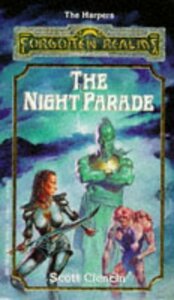Take a photo of a barcode or cover
The story is hard to follow at times and full of gaps. I was definitely unimpressed.
I picked this up because our current D&D campaign features the Harpers and I was curious about the organization. This book is the most mature D&D novel that I have read in terms of sex and violence. I enjoyed the story. It is a quick read and has plenty of action. My favorite part of the book is the monsters. Rather than having normal D&D fair such as orcs or hobgblins, the monsters are like something out of a Clive Barker novel. In fact, this is a well done horror/D&D crossover.
adventurous
dark
emotional
fast-paced
Others have highlighted the technical issues with the writing. The first third of the book was so full of “men writing women” tropes, including when describing 14 year old Krystin, I was being taken out of the world every time a new character showed up. The author seemed to be enjoying writing sexual tension into every relationship possible and I was struggling to stick with it. That’s not to mention the ridiculous cover art.
The back half of the book is almost like it was written by someone else because the lens of everyone being hot and attracted to each other was abandoned and it carried on with a quite enjoyable story. My guess is this shift was meant to show Myrmeen’s growth as a character as she moved from “cougar widow” to “maternal role model” as the book is written mostly from her perspective. Whatever the reason, I found the slog of the first part mostly worth getting through to what is an overall good inclusion in the Harper series.
I think if this story was written by someone less worried about the shapely nature of each named character it would have been one of the best books in the Harper series.
The back half of the book is almost like it was written by someone else because the lens of everyone being hot and attracted to each other was abandoned and it carried on with a quite enjoyable story. My guess is this shift was meant to show Myrmeen’s growth as a character as she moved from “cougar widow” to “maternal role model” as the book is written mostly from her perspective. Whatever the reason, I found the slog of the first part mostly worth getting through to what is an overall good inclusion in the Harper series.
I think if this story was written by someone less worried about the shapely nature of each named character it would have been one of the best books in the Harper series.
Graphic: Adult/minor relationship, Body horror, Child abuse, Violence, Blood, Trafficking, Abandonment
Ideas that could have made a nice book gone... nowhere? If you handle it more like an outline, taking out the skeleton, the key factors, and some worthy moments of the books, and then reshape it, you could actually get something good.
Scott Ciencin wrote two of my least favorite novels in the Forgotten Realms line to date: [b: Shadowdale|650584|Shadowdale (Forgotten Realms Avatar #1)|Scott Ciencin|https://images.gr-assets.com/books/1389179074s/650584.jpg|2333719] and [b: Tantras|650579|Tantras (Forgotten Relalms Avatar #2)|Scott Ciencin|https://images.gr-assets.com/books/1389179074s/650579.jpg|556716], in the Avatar series. As a result, I was dreading The Night Parade. Yes, I had to read it, in my ill-conceived quest of reading the Forgotten Realms novels in publication order. There was some hope that this would be a better book; I saw that he had written several other novels in the interim, and here he had freedom to write whatever he wanted, not bound to the dictates of a shared trilogy with a pre-stated outcome (i.e. the changes to Toril that the whole "Time of Troubles" god-changing events required). I was also aware that he died a few years ago, suddenly, in his early 50's, and did not want to think ill of the dead. So there I was, entering this with charitable thoughts, and.... it was not good.
The story was all over the place. Most scenes were highly random. Characterization was awfully weak. The characters were devoid of emotional resonance. The cardinal rule of half-decent writing, "Show, don't tell" was violated all over the place. And I cannot begin to count the number of times that a section or chapter ended with the suggestion that a character died, only to have them suddenly reappear a few pages later, usually first re-seen as the tip of a sword thrust through an enemy just before it slew another character. Taking just one sentence at a time, or sometimes even a whole paragraph, the prose was not bad; Ciencin had some worthy descriptive capacity, but that seems to be the extent of his wordcraft.
It was also weak as a Forgotten Realms-based adventure. "The Harpers" association was used solely as a cheap motivational tool to explain away why the dull adventurers would bother to go after these enemies, when only the main character had any personal stake. The monsters were not even D&D-canonical. Not that they have to be, but one has certain expectations with licensed pulp fantasy fiction. The "Night Parade" of demons concept is taken, I think, from Japanese folklore.
Finally, the cover art by Fred Fields; bizarrely bad depiction of Myrmeen Lhal, with a too-big unattractive head, armor that strangely conforms to her breasts, in a weird pose with her butt sticking out as she looks over her shoulder but not at the pair of monsters also on the cover. Some people think the 80's were tacky, but the early 90's really had little going for them style-wise. One of the portrayed monsters is presumably the big bad, Lord Sixx, who in the novel has eyes all over his body in sets of six (get it?), but appears without any extra eyes. Alternatively it is just a random Djinn-looking dude who does not even appear in the book.
Back on the shelf this goes, never to see the light of day again.
The story was all over the place. Most scenes were highly random. Characterization was awfully weak. The characters were devoid of emotional resonance. The cardinal rule of half-decent writing, "Show, don't tell" was violated all over the place. And I cannot begin to count the number of times that a section or chapter ended with the suggestion that a character died, only to have them suddenly reappear a few pages later, usually first re-seen as the tip of a sword thrust through an enemy just before it slew another character. Taking just one sentence at a time, or sometimes even a whole paragraph, the prose was not bad; Ciencin had some worthy descriptive capacity, but that seems to be the extent of his wordcraft.
It was also weak as a Forgotten Realms-based adventure. "The Harpers" association was used solely as a cheap motivational tool to explain away why the dull adventurers would bother to go after these enemies, when only the main character had any personal stake. The monsters were not even D&D-canonical. Not that they have to be, but one has certain expectations with licensed pulp fantasy fiction. The "Night Parade" of demons concept is taken, I think, from Japanese folklore.
Finally, the cover art by Fred Fields; bizarrely bad depiction of Myrmeen Lhal, with a too-big unattractive head, armor that strangely conforms to her breasts, in a weird pose with her butt sticking out as she looks over her shoulder but not at the pair of monsters also on the cover. Some people think the 80's were tacky, but the early 90's really had little going for them style-wise. One of the portrayed monsters is presumably the big bad, Lord Sixx, who in the novel has eyes all over his body in sets of six (get it?), but appears without any extra eyes. Alternatively it is just a random Djinn-looking dude who does not even appear in the book.
Back on the shelf this goes, never to see the light of day again.
A 2.5 out of 5 effort really, but I'll mark it up as it attempts to alter the formula. It tries its hardest to be uncommonly deep for a D&D novel, and I'll admit there's a few concepts here that give it a bit of lustre over some of its peers. But when it's all weighed up, this is still popcorn. No characterisations to speak of, and the writing is only just there. It's the story and the nature of the antagonists that make this effort stand out a little from the masses around it. But not quite.




